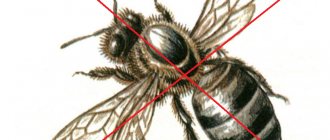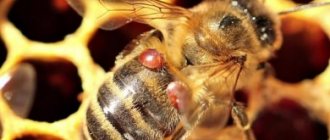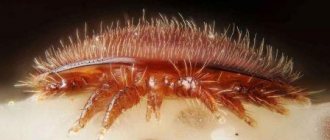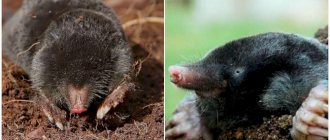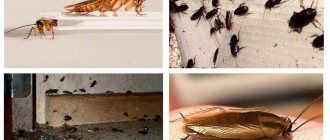Outwardly, all bees are similar, but in fact there is a strict classification of these insects. Breeds of bees with descriptions and photos will help you not only distinguish between these beneficial insects, but also learn how to choose the right species depending on the climatic conditions of the region.
Recommendations for choosing the best breed, as well as descriptions of the most popular species for temperate climates, can be found in this article.
How to choose bees
Bees are hymenopteran insects and are used to produce honey and other products. South Asia is considered the birthplace of insects, and from there these insects spread throughout the world.
A characteristic feature of this species is that it lives in families consisting of a queen, several tens of thousands of worker individuals and several hundred (or thousands, in large families) drones. It is noteworthy that in the summer the number of worker bees increases, and in winter it decreases significantly.
Note: The only full-fledged female in the family is the queen, who lays eggs in the warm season. Drones, workers, and new queens are subsequently hatched from them. Interestingly, the life expectancy of the queen directly depends on the number of worker bees in the colony. If there are only a few of them, the queen will live no more than three days, but in large families one queen can live up to five years.
As a rule, after two to three years, the queen’s egg production sharply decreases, so she is replaced by a younger individual. A productive queen lays up to 2.5 thousand eggs per day, and during the season this figure can grow to 200 thousand.
The queen almost never leaves the hive. The only exception may be the period of swarming and mating. In addition, if a queen from one family meets another, a fight will certainly break out between the insects, and the stronger and more dexterous representative will win.
A characteristic biological feature is the ability to reproduce not only within the family, but also with other families. This process is called swarming.
Worker bees are only females, who, due to underdeveloped reproductive organs, cannot mate and lay eggs. It is these females who perform all the work in the hive: collect nectar and pollen, produce honey, build honeycombs, feed the larvae and the queen, and also guard the hive and monitor the optimal temperature conditions in it. Under natural conditions, workers independently replace the old queen with a young one.
Note: Sometimes, if there is no queen in a colony for a long time, some worker insects may begin to lay eggs. But since they are not fertilized, only drones hatch from them.
The lifespan of worker bees depends on the time of their hatching: summer bees live no more than 45 days, and autumn ones - up to 10 months. In addition, they are divided into two groups. Flightless (young) are almost constantly in the hive, and fly out of it only in good weather. Flyers are responsible for collecting pollen and nectar.
Figure 1. Visual differences between insects and classification of worker bees
Drones are males whose sole function is to fertilize the uterus. That is why they have well-developed genitals, but do not have organs for collecting pollen and secreting wax. Each colony contains several hundred or even thousands of drones, although the queen mates with only a few (usually 6-10 individuals). Drones reach sexual maturity at the age of 8-14 days, and after that they can not only mate, but also leave the hive, flying away from it to a distance of several kilometers. Figure 1 shows the main visual differences between the queen, workers and drones.
Note: Drones only live in the summer, as worker bees drive them out of the hive in the fall. Sometimes, if there is no queen in the family, some drones remain in the hive for the winter.
Interestingly, all insects go through the same stages of development, but they differ in duration depending on the type of insect:
- In the first stage, the “egg,” all insects develop in the same way: three days;
- The second stage, “larva before sealing,” lasts 5 days for the queen, 6 days for worker bees, and 7 days for drones;
- The last stage of development, "larva and pupa in a sealed cell", lasts 8 days in the queen, 12 in worker species and 14 in drones.
Accordingly, the development cycle of an adult insect is: 16 days for the queen, 21 days for workers, and 24 days for drones.
These are quite hardy insects. They can carry a load through the air, the mass of which corresponds to half the weight of the individual itself, and are capable of reaching speeds of up to 60 km/h. In addition, they have developed vision. They have five eyes (two on the sides and three on the crown), which distinguish objects by shape and color. Insects have a well-developed sense of smell, which allows them not only to distinguish flowers, but also to find the location of the hive. If bees sense danger, they may sting. Single bites are not dangerous, but multiple bites can cause severe allergies. That is why beekeepers use special protective clothing when working.
What to pay attention to
There are four main types of these insects: giant, dwarf, Indian and honey. Only the latter type is bred in homesteads, since it is this type that produces honey.
When selecting bees for breeding, several factors should be taken into account:
- Climate: most insects are adapted only to certain temperature living conditions. For example, Central Russians tolerate cold well, while Italians tolerate hot climates;
- Productivity: the ability of the queen to lay the maximum number of eggs directly affects the survival of the family;
- Nectar collection and honey production: Anatomically, some insects have longer proboscis, which allows them to collect nectar from more plants.
Figure 2. The most productive species: 1a and 1b - Italian, 2a and 2b - Ukrainian steppe.
You should also take into account the tendency of insects to swarm, since during this period their honey production decreases. Italian and Ukrainian steppe are considered optimal for breeding (Figure 2). Such species are highly productive and calm in nature, but require additional care in winter and protection from diseases.
In addition, there are many breeds, each of which has its own distinctive characteristics.
Peculiarities
Insects are not artificially bred, and only those types that are characteristic of a given climatic zone and have already managed to adapt to living conditions are grown for breeding.
Figure 3. Representatives of the breeds: 1 - Central Russian, 2 - gray mountain Caucasian, 3 - yellow Caucasian, 4 - Ukrainian steppe (uterus)
For our country, the following types are considered the best (Figure 3):
- Central Russian: fairly large insects of dark gray color. The queen is highly productive, and the honey-bearing capacity is average. During the season, you can collect no more than 30 kg of honey from one family. Representatives of the species are conservative in nature and have difficulty switching to new honey-bearing areas. In addition, they are quite aggressive, but are highly resistant to cold and disease.
- The Caucasian mountain gray is smaller and lighter than the Central Russian one. In addition, the queen is not highly fertile, and the workers are not honey-bearing. From one family you can collect no more than 29 kg of honey per season. However, these disadvantages are fully compensated by their advantages: they productively use poor sources of honey collection, easily switch to new areas, have a peaceful character, and thanks to their long proboscis they can collect nectar from a much larger number of plants than representatives of other species. In addition, they are weakly susceptible to swarming (no more than 5% of individuals from a family), so in the summer the fertility of insects practically does not decrease. However, they are very sensitive to cold and putrefactive diseases. Nevertheless, it is precisely this that has become widespread not only in Russia, but also abroad.
- The yellow Caucasian is similar in size to the gray mountain, but slightly exceeds it in fertility. The insects are gray with bright yellow stripes. Quite peaceful, characterized by average playfulness, tolerate hot and dry climates, but can attack other families and are sensitive to diseases. At the moment, the yellow Caucasian is gradually being absorbed by the gray mountain.
- The Ukrainian steppe was transformed from the Central Russian one, adapting to southern living conditions. Representatives are smaller in size than Central Russian ones, but they also have a much longer proboscis, which has a positive effect on productivity. In addition, Ukrainian steppe species are distinguished by their high honey production (up to 40 kg per family per season), resistance to temperature changes and diseases.
- The Carpathian is in many ways similar to the Ukrainian steppe. The only difference between insects is that the Carpathian ones have a much longer proboscis. They are distinguished by average leafiness and winter hardiness and an exceptionally peaceful character (Figure 4).
- Representatives of the Italian breed correspond in size to the Central Russian ones, but are significantly superior to them in fertility. A distinctive feature is its golden color with bright yellow stripes. They have a peaceful nature, use a variety of types of plants very well to collect nectar, but do not have sufficient resistance to cold and disease.
- Krajinskaya was brought from Austria. They are distinguished by their gray color with a silver tint. Fertility is average, but insects are characterized by rapid spring development. They make excellent use of various sources of honey collection, but their resistance to cold and disease is average.
- The Far Eastern ones were formed through the process of mutation of insects representing several species. Due to this, they are distinguished by their small size, gray color and low fertility. Despite their high tendency to swarm, insects are peaceful in nature and can use the earliest plants to produce honey.
Figure 4. Breeds: 1 - Carpathian, 2 - Krajina, 3 - Italian, 4 - Far Eastern
When selecting insects for breeding, be sure to take into account the climatic characteristics of the region, since most species are very sensitive to cold and require additional care in winter. More detailed information about the most popular Italian breed in the world is given in the video.
Rules
Finding a purebred bee, unfortunately, is quite difficult, since so-called hybrids are bred in most apiaries. But, if you have clearly set yourself the goal of choosing the best breed based on photos and descriptions, we recommend using some useful tips.
Among the basic selection rules are:
- Assessment of appearance: each breed is formed under the influence of certain climatic conditions, therefore insects of different species are radically different from each other in appearance and size.
- The climatic conditions in which the apiary will be located also play an important and sometimes decisive role. For example, Italian ones can be bred in warm climates, but they are not suitable for temperate and cold climates, as they are not winter hardy.
- The peaceful nature of insects is an important criterion for novice beekeepers. For example, representatives of the Caucasian will bring honey even if the beekeeper accidentally damages their nest, and the Central Russians have a rather aggressive character.
To make it easier for you to choose a breed for your apiary, we present the names, photographs and descriptions of the most popular species.
How to determine the breed of bees: video
You can learn to identify bee breeds with the help of a video. Its author talks about the characteristics of certain types of insects and the criteria by which they can be distinguished.
How to attract insects to your site
To attract osmium to the site, several conditions must be met:
- There should be a large number of spring nectar plants near the site.
- Availability of nesting houses.
It's not difficult to build them. The easiest option is to hang bunches of reeds with sufficient length (10-20 mm) and diameter (6-10 mm) under a shed or attic. The tube should be closed on one side. It is advisable not to use low-growing marsh reeds due to their small diameter.
A box filled with reeds or a tin containing plant stems will also work. The presence of houses and water will definitely ensure the arrival of bees. From April onwards they will begin to actively pollinate fruit-bearing plants.
This video explains how to make nesting houses for Osmia bees yourself:
Breed of Karnika bees and their characteristics
The description of carnika bees primarily concerns subspecies or strains. There are four of them: carnika, Italian, Caucasian and dark forest.
Regardless of the strain, all insects of this species are characterized by high productivity and low feed consumption, therefore they tolerate winter well even in lean years.
The insects are gray, with small patches of yellow, the body is short and covered with numerous villi, which makes the insects look shaggy.
Characteristics of carnival bees include the following indicators (Figure 5):
- High productivity allows you to get honey even from a weak harvest;
- The peaceful nature allows the beekeeper to work with insects even without protective clothing;
- Economical consumption of feed increases survival in winter, and the family will collect honey even in the absence of a queen.
Figure 5. Features of karnik bees
Among the disadvantages are the late appearance of brood, especially in warm and long autumn conditions, as well as low productivity during the second bribe.
This feature is due to the fact that bees spend almost all their energy on the first bribe.
The location and number of eyes of a bee
Regardless of the class of the insect (worker bee, drone, queen bee), it has five eyes. On the head of any individual are located:
- three small dorsal ocelli (ocelli);
- two large eyes with a complex structure.
The eyes of the second type are called facet eyes because they are located on the sides of the head and are formed from a huge number of facets. Such organs of vision have an oblong shape. They are bulges that point downwards.
Compounded eyes are formed from ommatidia - these are structural units. They are densely located, neighboring ommatidia are closely adjacent to each other. Each of these functional units that make up the facet organ has a refractive, insulating and receptive part.
Interestingly, the size of each honey bee eye is on average 2 millimeters. Moreover, the number of eyes remains unchanged for each individual. The visual organs of drones have the most significant area; the second place according to this criterion is occupied by working individuals, and the uterus closes the list.
Buckfast bee breed and their characteristics
A description of the Buckfast bee breed and their characteristics will help to objectively evaluate all the pros and cons of the species, and decide whether it is worth breeding such insects in the apiary.
Firstly, it should be taken into account that the breed was bred by breeders, and it is based on Italian bees, therefore all subspecies of buckfast have a characteristic yellow color. Despite the components of the hybrids, all insects of this species have some common features (Figure 6):
- Insects practically do not swarm, but at the same time they produce a fairly large amount of brood. Moreover, it is not recommended to limit family growth, as this may negatively affect honey yield.
- Insects collect little propolis, since the Egyptian breed was used to create the hybrid;
- They are distinguished by a calm character and do not show aggression when the beekeeper works with the hive.
Figure 6. External characteristics of buckfast bees
In addition, the queens of this breed are highly fertile, and the insects themselves have excellent endurance, so in most cases they tolerate wintering well. However, these insects are not suitable for northern regions due to their insufficient frost resistance.
What is the structure of a bee's eyes?
To the unusual question about how many eyes a bee has, we immediately answer: “There are only five eyes, 3 simple, and 2 complex, consisting of facets.” Bees have a complex visual system. It unites various organs of the visual apparatus, which are responsible for performing certain functions.
Such organs help bees navigate in space, compensate for insufficient illumination, and allow them to smell flowering at a distance of up to 1 km. They are not only responsible for the perception of the environment, but also perform additional functions. The working honey bee has eyes with a complex structure on the sides of its head. They are formed by a huge number of special cells. They are called facets. Bees see their surroundings as a mosaic made up of tiny particles. Each facet is responsible for forming its own part of the picture.
Carpathian bee: description
The Carpathian bee, or karpatka, stands out among other breeds by its early flight, that is, insects begin to collect nectar much earlier than other species. In addition, honey collected by representatives of the Caucasian species contains little sugar, and the insects themselves tolerate wintering well (Figure 7).
Figure 7. Carpathian breed
Among the advantages of carpathians are their peaceful nature and high productivity. In addition, they tolerate winter well, practically do not swarm and get sick little. But their winter hardiness is low, so the Carpathian breed is not recommended for breeding in the northern regions.
Video: A look at the apiary through the eyes of a bee
It is worth noting that worker bees rarely fly in the dark, with rare exceptions. This is caused not only by the need for night rest, but also by a decrease in the strength of the electromagnetic field. This factor contributes to the disruption of spatial orientation in bees, so they generally prefer not to fly at night. Experimentally, it was possible to find out that these insects are able to distinguish the shapes of objects.
Central Russian breed: characteristics
Central Russian bees are considered one of the largest. They have a dark gray body color without yellowness (Figure 8).
Figure 8. Features of Central Russian bees
They have high productivity, resistance to cold and disease. However, insects are quite aggressive in nature, and when working with them it is imperative to wear protective clothing. This breed is recommended to be bred in the northern regions, since in the south they swarm heavily and significantly reduce productivity.
Features of the eyes of the queen, drone, worker bee
If you compare the visual organs of bees of different classes, you will find differences. The worker bee has simple eyes located on the crown of the head. In contrast, in the drone and queen bee such organs are located directly on the forehead. Insects have different numbers of facets (ommatidia). In queen bees their number often reaches 4,000, in worker bees - 5,000, in drones - 9,000.
The compound eyes are clearly visible in drones, since they converge on the crown of the head. In the queen bee and worker bee, it is difficult to distinguish these visual organs at a superficial glance. In all the insects described, simple ocelli have a primitive structure. These are special transparent lenses; they protrude significantly from the head. Each of them separately captures images.
Caucasian breed
The Caucasian breed includes many subspecies, which, although they have some differences, still have some common features (Figure 9).
Note: The diversity of subspecies is explained by the fact that they formed in different climatic conditions. For example, valley Caucasian ones can collect honey even in extreme heat, while high mountain ones can collect honey when the temperature drops to +6 degrees.
A distinctive feature of the breed is its high flight duration. Bees leave the hive early in the morning and return late in the evening, which allows them to collect a fairly large amount of honey. In addition, the nectar collection period lasts from early spring to late autumn, which allows us to consider the breed one of the most productive.
Figure 9. External features of Caucasian bees
Also, Caucasian bees easily adapt to different weather conditions and produce a lot of propolis, which is used to insulate nests for the winter. Despite these features, insects do not tolerate wintering well, so the main task of the beekeeper is to properly prepare the hives and provide the insects with sufficient food. In addition, they often get sick and are very sensitive to dampness.
Outer coverings
Bees have a body that has three sections. It makes no difference whether it is an ordinary bee, a queen bee or a drone. These sections include the head, chest, and abdomen. The first part is endowed with antennas, or antennae, and eyes. The oral apparatus is also located here. The brain is located inside the head and is responsible for the entire nervous system of the insect.
The second department has three segments. There are wings and paws on the chest.
The abdomen is divided into 11 segments. Inside it are located all the organs that are necessary for life.
This type of individual differs from ordinary insects in its complicated structure. The changes in their structure were influenced by both the external environment and the way they live. The cover on the outside can protect against various chemicals and lack of moisture in the internal organs. They are attached precisely to the cover.
The head is a part of the body located in the front, resembling a chitinized box. In some ways, it may resemble a triangle on which two openings are located - the occipital and oral. It becomes strong due to the presence of a chitinous skeleton located inside. At the bottom of the head is the bee's mouthparts. It has an upper and lower lip, as well as an upper and lower jaw.
The mouth opening is covered by the upper lip, on the side of which there are chitinized, unsegmented plates. Bees suck in liquid food with part of their mouthparts, which have an unpaired lower lip and two maxillae.
Italian breed: photo
A characteristic feature of Italian bees is their unusual bright yellow body color, by which they can be easily distinguished from others (Figure 10). The queens are highly fertile, and insects have high resistance to disease and a fairly peaceful nature.
Figure 10. What the Italian breed looks like
They are highly productive, and during the honey harvest period they easily switch from plants that contain less nectar to those that have the opportunity to harvest a more abundant harvest. Insects secrete a lot of wax, but do not survive wintering well due to their low resistance to cold. That is why Italian bees are recommended to be bred only in the southern regions.
Where does the wild bee live?
The favorite natural habitat of the sang is forest plantations and forest areas. The main condition is distance from roads, industrial centers, and human settlements.
The ideal place for a family is a hollow. The nest can also be built between tree branches in a dense crown, in crevices of walls or mountains. Burrows dug in the soil are also suitable for settlement.
Sometimes a convenient place to live is close to a person. A gap under the roof of a barn or house, the space between frames, etc. is suitable.
A place for a family home should be suitable in many ways. The most important of them is the presence of a constant source of water nearby.
Movement of honey-bearing individuals
Bee pupa
Only in the group of insects did an organ such as wings appear, which helps them move. By looking at the pupa, you can better understand how the wing works. They resemble bags that, when connected to the body, protrude out a little. You can see the presence of nerve branches in them. They also contain trachea and blood. The walls themselves are made of epidermis, which secretes the cuticle. It will be soft at first, but will then harden. The wing will be fully formed when the pupa sheds its skin.
In the photo you can see the doll.
To straighten and take on the shape of double plates, the body drives blood into the wing. To form a full-fledged wing, the plates connect and grow together.
The nerves, as well as the trachea, are replaced by groove-like projections. After connecting the protrusions, tubes emerge. They form veins in the wing. Tracheas, blood and nerves move into the slit-like spaces.
The film, located at the base, is connected to the mesothorax and has a pair of chitin plates. When the wing moves, the plates serve as a transmission mechanism. The wing moves due to striated muscles located inside the mesothorax. They are considered more active than smooth muscles. In different areas, the muscles have different refraction, so it seems that light and dark stripes alternate.
Description provided. Now let's see what bees eat.

